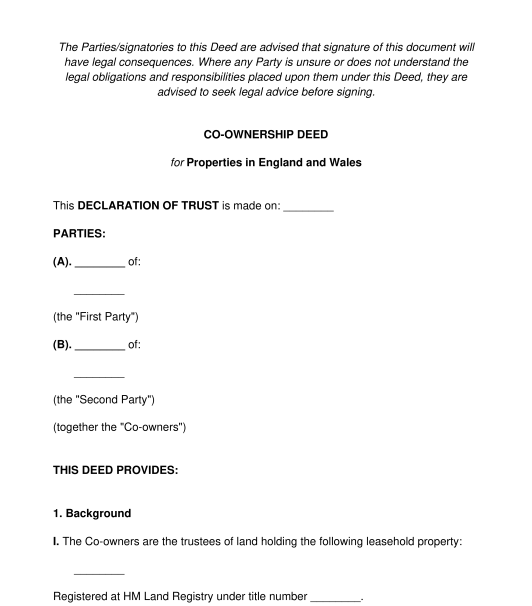 20/09/2025
20/09/2025

Answer a few questions and your document is created automatically.

Your document is ready! You will receive it in Word and PDF formats. You will be able to modify it.

 20/09/2025
20/09/2025
 Word and PDF
Word and PDF
 2 to 3 pages
2 to 3 pages
A co-ownership deed is used by property owners to declare that a property is to be owned as tenants in common in defined shares. This deed therefore severs a joint tenancy. This deed is designed for properties that are based in England and Wales.
A co-ownership deed might:
Yes. If the parties would like to sever a joint tenancy and allocate their ownership in different shares, then it is necessary to do this via deed.
A tenancy in common is a way of owning property. In a tenancy in common, each party will own an individual share (which does not have to be an equal share). A tenant in common can stipulate that their share of the property will go to somebody else in their will. A tenancy in common is therefore frequently used where somebody wants to leave shares of their property to somebody else after their die (e.g. children from a former marriage), or where one party has contributed more to the property and the parties wish for this to be reflected in the ownership.
Where a property is owned as joint tenants, neither owner has a defined share as they both own the whole of the property. When a party to a joint tenancy dies, the other owner will own the whole of the property in their sole name. It is not possible for a joint tenant to leave a portion of the property to somebody else via a will.
Before entering into this agreement the parties should be joint tenants of the property. They should:
The parties to the deed will be the legal owners of the property, who will own the shares of the property as a tenancy in common under the deed.
The agreement is designed to be a permanent agreement, which will end upon the sale of the property.
Once each party has executed the document as a deed in the presence of a witness, they should each retain a copy. They should register the agreement with Land Registry.
The parties should register the agreement with Land Registry*.
The government website has instructions on how to register the agreement.
The document must be executed as a deed*. The signature of each party to a deed must be witnessed. The witness should:
The document is not reviewed by a lawyer to ensure that the legal content applies to the personal situation of the parties. For assistance finalising, reviewing and executing a deed, advice should be sought from a lawyer who is regulated by an approved regulator in the legal services sector. It is possible to search for a lawyer using the Law Society – find a solicitor webpage.
There may be costs where the parties choose to:
The document is not reviewed by a lawyer to ensure that the legal content applies to the personal situation of the parties. For assistance finalising, reviewing and executing a deed, advice should be sought from a lawyer who is regulated by an approved regulator in the legal services sector. It is possible to search for a lawyer using the Law Society – find a solicitor webpage.
A co-ownership deed will:
The following laws are relevant to a co-ownership deed:
You fill out a form. The document is created before your eyes as you respond to the questions.
At the end, you receive it in Word and PDF formats. You can modify it and reuse it.
A guide to help you: Signing Documents in England and Wales
Residential Property Co-ownership Deed - Template
Country: United Kingdom